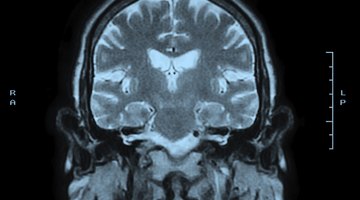Baby Nose Development
Your baby's development as an embryo begins with fertilization of the egg by a sperm, followed by rapid cell division. Initial division results in the formation of a ball of cells that then folds, divides, changes and grows into your baby with a genetically determined set of characteristics and appearance.
Development of facial features starts soon after conception and progresses rapidly, with distinct structures such as the nose becoming recognizable by the 12th week of your pregnancy, says "Cummings Otolaryngology: Head and Neck Surgery, 5th edition."
Time Frame
Gestation refers to the period of growth in the uterus from conception to birth. Different organ systems develop and grow during different phases of gestation, with development of many critical structures occurring in the first trimester of pregnancy. Further growth and refinement of structures and organs continues in the second and third trimesters.
Your baby's nose begins to form as part of the fetal airway at about four weeks gestation. By the end of the first trimester, the basic components of the nose have formed, according to "Cummings Otolaryngology." Further refinement in structure occurs throughout the rest of your pregnancy.
Prenatal Development

A Description of the Fetal Heart Development Stages
Learn More
At about one month of gestational age, a fetal brain begins to develop. Just below the developing brain, an indentation and several bumps form that will become your baby's face. On one of these bumps, called the "frontonasal prominence," two oval-shaped thickenings grow. During the fifth and sixth weeks of gestation, indentations form in these thickenings and develop into nasal pits, which later grow into the nostrils and nasal cavity, explains the April 2009 issue of "Otolaryngologic Clinics of North America." A membrane that eventually becomes the nasal septum separates the primitive nostrils.
External structures, such as the outside walls of the nostrils and the cartilage and bones around your baby's nose, develop and grow throughout your pregnancy.
Defects
As your child's nose forms, the nasal pits get deeper and eventually open into the pharynx--the back of the throat. For this to happen, a membrane that separates the back of the fetal nose from the pharynx must dissolve before birth to allow connection between the two structures.
Choanal atresia results when this membrane does not disintegrate properly, causing an incomplete opening and breathing problems for your newborn, explains "Otolaryngologic Clinics of North America." Choanal atresia affects one in 7,000 babies and can be life-threatening if both sides of the nasal airway are blocked, according to MedlinePlus. However, surgical correction provides a cure for severe cases.
Cleft palate represents another example of incomplete development of the nose and pharynx. Dr. Thomas Marino of the Temple University School of Medicine describes plates of tissue that close in from the sides of the developing face at about the same time that the septum grows to separate the nares. The plates, called maxillary processes, form the roof of the mouth and separate the mouth from the nose. If these plates don't close completely, a cleft palate deformity results.
Post-Natal Development

How Do Babies Breathe in the Womb?
Learn More
Nasal development continues after birth, according to the "Nelson Textbook of Pediatrics." When your infant breathes, air passes almost exclusively through the nose, a situation called "obligate nasal breathing." Newborns with nasal congestion sometimes struggle to breathe, especially during sleep. By the time your baby reaches 6 months of age, the internal diameter of the nose doubles, providing more airflow and less obstruction with congestion.
Precautions
Because generation of the nose and face occurs so early in gestation, damage to these developing structures may occur before pregnancy is discovered.
Your gynecologist may prescribe vitamins, especially folic acid, even before you get pregnant. Folic acid, well known for preventing spine and brain problems, likely provides some protection against cleft palate and other facial defects, according to the "Journal of Nutrition Workshop Supplement" from 2002.
If you plan to become pregnant, ask your doctor for recommendations regarding vitamins, diet and lifestyle changes to ensure a safe and healthy pregnancy.











